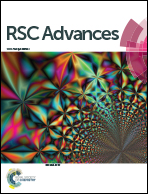A highly active molybdenum multisulfide electrocatalyst for the hydrogen evolution reaction†
Abstract
We prepared a highly active molybdenum multisulfide (MoSx) hybrid material by an arc-melting method, which exhibits superior activity in acid media with a low overpotential of 156 mV at j = 10 mA cm−2, and a Tafel slope of 58 mV dec−1, surpassing most existing molybdenum-sulfide-based catalysts.


 Please wait while we load your content...
Please wait while we load your content...